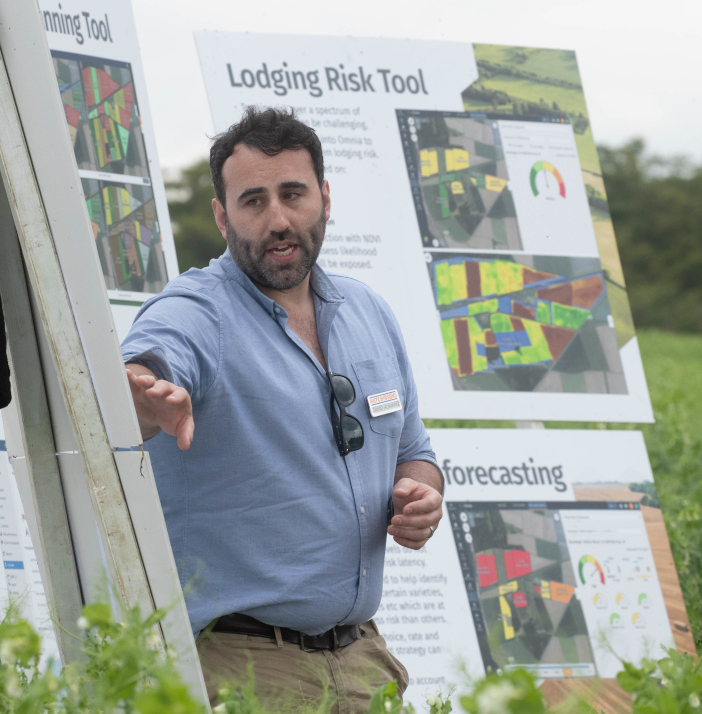Hutchinsons’ head of ICM, Dave Howard, is urging growers to use the Omnia wheat disease risk forecasting model to prioritise spray applications.
“The model provides a baseline risk assessment for any location, based on factors including; Recommended List variety scores, drilling date and critically historic and forecast weather data from the Omnia Climate module,” he said.
“This gives growers a visual representation of where the main risks are and strategically plan control programmes accordingly. For large cropping areas, there can be a temptation to treat everything as one. However, even relatively small differences in drilling date can make a big difference to disease risk.”
He pointed out that this is particularly true for varieties with medium Septoria resistance scores (RL rating 5-6), sown around late September and early October. “These make decisions challenging as they can neither be approached as a resistant variety or a susceptible variety, so other risk factors become highly important.

“Temperatures fluctuate quite a lot at that time of year, so 7-10 days variation in drilling date can make a big difference to the speed of disease movement and risk going into spring.”
Rainfall in April and May has long been associated with increased Septoria incidence, but 2021 showed that given the right conditions it can take off rapidly later, even from a low base disease level. So, Mr Howard says the Omnia model is being further developed to provide a way of predicting the severity of Septoria infections based on weekly rainfall data.
Septoria risk
Early sowing and a largely mild, damp winter mean that many cereal crops are at relatively high disease risk going into spring, making early fungicides a worthwhile investment, says Hutchinsons technical development director, Dr David Ellerton.
“We saw a lot of rust, mildew and Septoria on lower leaves at the start of the year, and although January frosts slowed disease down, generally thick, early-sown crops will be at higher risk if conditions are conducive,” Dr Ellerton said.
“Focus of the first fungicide spray, usually applied to winter wheat around growth stage 25-30, should be yellow rust control. If you’ve got yellow rust, it’s important to knock it out early with a tebuconazole or metconazole-based fungicide. Including a strobilurin such as azoxystrobin or pyraclostrobin, can bring extra persistence, however, strobilurins should not be used alone.
“Resistance management guidelines state strobilurins must be mixed with a fungicide with a different mode of action.”
Dr Ellerton advises when planning spray programmes, to prioritise susceptible varieties rated 3 or 4, such as Skyfall, KWS Kinetic, KWS Zyatt or RGT Wolverine, which were hit particularly hard by yellow rust last year, but will give the greatest yield response to treatment.
“Varieties with higher Recommended List ratings cannot be ignored though, especially if it is based on adult resistance, which may not kick in until late in the season,” he said.
“Some varieties with reasonable adult resistance, such as KWS Barrel or RGT Gravity (both rated 6) can still be vulnerable to disease as young plants. If disease establishes early, it can cause significant damage before adult resistance takes effect, so needs controlling.”
Early treatment is paramount for yellow rust control, but Dr Ellerton advises growers to check product labels carefully and consult their agronomist, as some products cannot be applied before GS 30.
“Straight tebuconazole or azoxystrobin, for example, cannot be used pre-GS 30, whereas some mixes containing tebuconazole can. Also, remember nitrogen strategy affects disease risk, stressed crops, or those with excess nitrogen, are potentially more prone to yellow rust.
“Last year’s emergence of Septoria races with virulence to Cougar makes early protection particularly important for varieties with Cougar parentage, such as RGT Saki or KWS Firefly,” he added.
Following the withdrawal of multi-site chlorothalonil, which was the go-to option, folpet is now the main fungicide for Septoria protection where risk is high.
“But remember, the focus isn’t on curing Septoria that appeared on lower leaves over winter, it’s about protecting upper leaves as they emerge so it may be worth holding back folpet for the T1 and T2 and building plant protection in other ways.”
Where mildew is a threat, Dr Ellerton says prothioconazole offers reasonable early season control, either as a straight product or in a mix with tebuconazole or fluoxastrobin. “The strongest mildewicide, cyflufenamid, cannot be used until the beginning of stem elongation.”
He believes the biostimulant Scyon can play a useful role within integrated disease control programmes. “Its combination of naturally occurring, signalling metabolites strengthens the plant’s natural defences and maximizes nutrient uptake, making plants healthier and better able to fight off disease.“
“If you’ve got a high-risk variety for Septoria, Scyon at T0 is worth considering to build protection. Improving nutrient uptake is always beneficial, especially if growers are looking to apply less nitrogen fertiliser this season,” he said.


